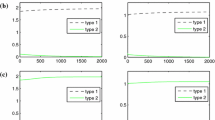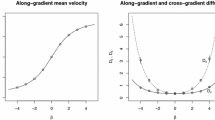Abstract
The purpose of this article is to introduce a diffusion model for biological organisms that increase their motility when food or other resource is insufficient. It is shown in this paper that Fick’s diffusion law does not explain such a starvation driven diffusion correctly. The diffusion model for nonuniform Brownian motion in Kim (Einstein’s random walk and thermal diffusion, preprint http://amath.kaist.ac.kr/papers/Kim/31.pdf, 2013) is employed in this paper and a Fokker–Planck type diffusion law is obtained. Lotka–Volterra type competition systems with spatial heterogeneity are tested, where one species follows the starvation driven diffusion and the other follows the linear diffusion. In heterogeneous environments, the starvation driven diffusion turns out to be a better survival strategy than the linear one. Various issues such as the global asymptotic stability, convergence to an ideal free distribution, the extinction and coexistence of competing species are discussed.








Similar content being viewed by others
References
Beck, M., & Wayne, C. E. (2011). Using global invariant manifolds to understand metastability in the Burgers equation with small viscosity. SIAM Rev., 53(1), 129–153.
Berg, H. C., & Brown, D. A. (1972). Chemotaxis in Escherichia coli analysed by three-dimensional tracking. Nature, 239(5374), 500–504.
Burnstock, G., & Verkhratsky, A. (2009). Evolutionary origins of the purinergic signalling system. Acta Physiol. (Oxf.), 195(4), 415–447.
Chapman, S. (1928). On the Brownian displacements and thermal diffusion of grains suspended in a non-uniform fluid. Proc. R. Soc. Lond. A, 119, 34–54.
Chapman, S., & Cowling, T. G. (1990). The mathematical theory of nonuniform gases (3rd ed.). Cambridge: Cambridge Mathematical Library, Cambridge University Press. An account of the kinetic theory of viscosity, thermal conduction and diffusion in gases, in co-operation with, Burnett, D., with a foreword by Carlo Cercignani.
Collett, M., Despland, E., Simpson, S. J., & Krakauer, D. C. (1998). Spatial scales of desert locust gregarization. Proc Natl. Acad. Sci., 95(22), 13052–13055.
Cosner, C., & Lou, Y. (2003). Does movement toward better environments always benefit a population? J. Math. Anal. Appl., 277(2), 489–503.
Dieckman, U., O’Hara, B., & Weisser, W. (1999). The evolutionary ecology of dispersal. Trends Ecol. Evol., 14(3), 88–90.
Dockery, J., Hutson, V., Mischaikow, K., & Pernarowski, M. (1998). The evolution of slow dispersal rates: a reaction diffusion model. J. Math. Biol., 37(1), 61–83.
Ishii, S., & Kuwahara, Y. (1967). An aggregation pheromone of the German cockroach Blattella germanica l. (Orthoptera: Blattelidae). Appl. Entomol. Zool., 2, 203–217.
Johnson, M., & Gaines, M. (1990). Evolution of dispersal: theoretical models and empirical tests using birds and mammals. Annu. Rev. Ecol. Syst., 21, 449–480.
Johnson, E. C., Kazgan, N., Bretz, C. A., Forsberg, L. J., Hector, C. E., Worthen, R. J., Onyenwoke, R., & Brenman, J. E. (2010). Altered metabolism and persistent starvation behaviors caused by reduced AMPK function in Drosophila. PLoS ONE, 5(9), e12799.
Kareiva, P., & Odell, G. (1987). Swarms of predators exihibit “preytaxis” if individual predators use area-restricted search. Am. Nat., 130, 233–270.
Keeling, M. (1999). Spatial models of interacting populations. In J. McGlade (Ed.), Advanced ecological theory: principles and applications, Oxford: Blackwell Science.
Keller, E. F., & Segel, L. A. (1971). Model for chemotaxis. J. Theor. Biol., 30, 225–234.
Kim, Y.-J. (2013). Einstein’s random walk and thermal diffusion. Preprint http://amath.kaist.ac.kr/papers/Kim/31.pdf.
Kim, Y.-J., & Tzavaras, A. E. (2001). Diffusive N-waves and metastability in the Burgers equation. SIAM J. Math. Anal., 33(3), 607–633 (electronic).
Kim, Y.-J., Kwon, O., & Li, F. (2013a). Evolution of dispersal toward fitness with starvation driven diffusion. Preprint http://amath.kaist.ac.kr/papers/Kim/29.pdf.
Kim, Y.-J., Kwon, O., & Li, F. (2013b). Global asymptotic stability and the ideal free distribution in a starvation driven diffusion. J. Math. Biol. doi:10.1007/s00285-013-0674-6.
Larsen, S. H., Reader, R. W., Kort, E. N., Tso, W. W., & Adler, J. (1974). Change in direction of flagellar rotation is the basis of the chemotactic response in Escherichia coli. Nature, 249(452), 74–77.
Lee, H., Choi, M. K., Lee, D., Kim, H. S., Hwang, H., Kim, H., Park, S., Paik, Y. K., & Lee, J. (2011). Nictation, a dispersal behavior of the nematode Caenorhabditis elegans, is regulated by il2 neurons. Nat. Neurosci., 15(1), 107–112.
Lou, Y. (2006). On the effects of migration and spatial heterogeneity on single and multiple species. J. Differ. Equ., 223(2), 400–426.
Lou, Y., & Ni, W.-M. (1999). Diffusion vs cross-diffusion: an elliptic approach. J. Differ. Equ., 154(1), 157–190.
Lou, Y., Ni, W.-M., & Wu, Y. (1998). On the global existence of a cross-diffusion system. Discrete Contin. Dyn. Syst., 4(2), 193–203.
McPeek, M., & Holt, R. (1992). The evolution of dispersal in spatially and temporally varying environments. Am. Nat., 140, 1010–1027.
Mimura, M., & Kawasaki, K. (1980). Spatial segregation in competitive interaction–diffusion equations. J. Math. Biol., 9(1), 49–64.
Mittal, N., Budrene, E. O., Brenner, M. P., & van Oudenaarden, A. (2003). Motility of Escherichia coli cells in clusters formed by chemotactic aggregation. Proc. Natl. Acad. Sci. USA, 100(23), 13259–13263.
Okubo, A., & Levin, S. A. (2001). Interdisciplinary applied mathematics: Vol. 14. Diffusion and ecological problems: modern perspectives (2nd ed.). New York: Springer.
Ott, S. R., Verlinden, H., Rogers, S. M., Brighton, C. H., Quah, P. S., Vleugels, R. K., Verdonck, R., & van den Broeck, J. (2012). Critical role for protein kinase a in the acquisition of gregarious behavior in the desert locust. Proc Natl. Acad. Sci., 109(7), E381–E387.
Overton, J. M., & Williams, T. D. (2004). Behavioral and physiologic responses to caloric restriction in mice. Physiol. Behav., 81, 749–754.
Sakurada, S., Shido, O., Sugimoto, N., Hiratsuka, Y., Yoda, T., & Kanosue, K. (2000). Autonomic and behavioural thermoregulation in starved rats. J. Physiol., 526, 417–424.
Shigesada, N., Kawasaki, K., & Teramoto, E. (1979). Spatial segregation of interacting species. J. Theor. Biol., 79, 83–99.
Silverman, M., & Simon, M. (1974). Flagellar rotation and the mechanism of bacterial motility. Nature, 249(452), 73–74.
Tindall, M. J., Maini, P. K., Porter, S. L., & Armitage, J. P. (2008a). Overview of mathematical approaches used to model bacterial chemotaxis. II. Bacterial populations. Bull. Math. Biol., 70(6), 1570–1607.
Tindall, M. J., Porter, S. L., Maini, P. K., Gaglia, G., & Armitage, J. P. (2008b). Overview of mathematical approaches used to model bacterial chemotaxis. I. The single cell. Bull. Math. Biol., 70(6), 1525–1569.
Acknowledgements
This work has been started during Y.J.K.’s visit to the Center for Partial Differential Equations at East China Normal University, Shanghai, China. He would like to thank for the hospitality and support provided by the center during his stay. In particular, he wants to thank Wei-Ming Ni for his motivating questions and valuable lectures related to this work. Anonymous reviewers’ suggestions improved this article considerably and are greatly appreciated.
Author information
Authors and Affiliations
Corresponding author
Additional information
This research has been supported by National Research Foundation of Korea (no. 013-2011-1-C00002).
Appendix: Derivation of Non-isothermal Diffusion
Appendix: Derivation of Non-isothermal Diffusion
Let \(\{x^{i}:i\in\mathbb{Z}\}\) be a mesh grid and x i+1/2:=(x i+x i+1)/2 be the middle point between two adjacent grid points. Let V(x i) be the number of particles at x i, which jump randomly to one of two adjacent grid points every time interval Δt(x i). Define the walk length by Δx(x i+1/2):=x i+1−x i and let Δx(x i):=x i+1/2−x i−1/2.
Then, the particle flux that crosses the a midpoint x i+1/2 from left to right is \({V\over2\varDelta t} |_{x=x^{i}}\) and the one from right to left is \({V\over2\varDelta t} |_{x=x^{i+1}}\). Notice that the particle density is given by \(v={V\over\varDelta x}\), and hence the net flux is
If the Brownian motion or the random walk is in a homogeneous environment, we may assume that the mean free path Δx and the collision time Δt are constant, and hence \({\varDelta x\over \varDelta t}\) in the parenthesis of (41) can be taken out. However, if the temperature is not spatially constant, for example, they depend on the space variable and should stay inside. In conclusion, the diffusion flux for a non-isothermal case in n space dimensions is given by
where S and D are called the walk speed and diffusivity, respectively. Notice that the walk length is given by |Δx|=2nD/S. Therefore, the corresponding non-isothermal diffusion equation is
One might numerically check that this diffusion model gives the correct behavior of nonuniform random walks with nonconstant Δx and Δt. The numerical solutions of this diffusion model have been compared with Monte Carlo simulations in Kim (2013).
Rights and permissions
About this article
Cite this article
Cho, E., Kim, YJ. Starvation Driven Diffusion as a Survival Strategy of Biological Organisms. Bull Math Biol 75, 845–870 (2013). https://doi.org/10.1007/s11538-013-9838-1
Received:
Accepted:
Published:
Issue Date:
DOI: https://doi.org/10.1007/s11538-013-9838-1




